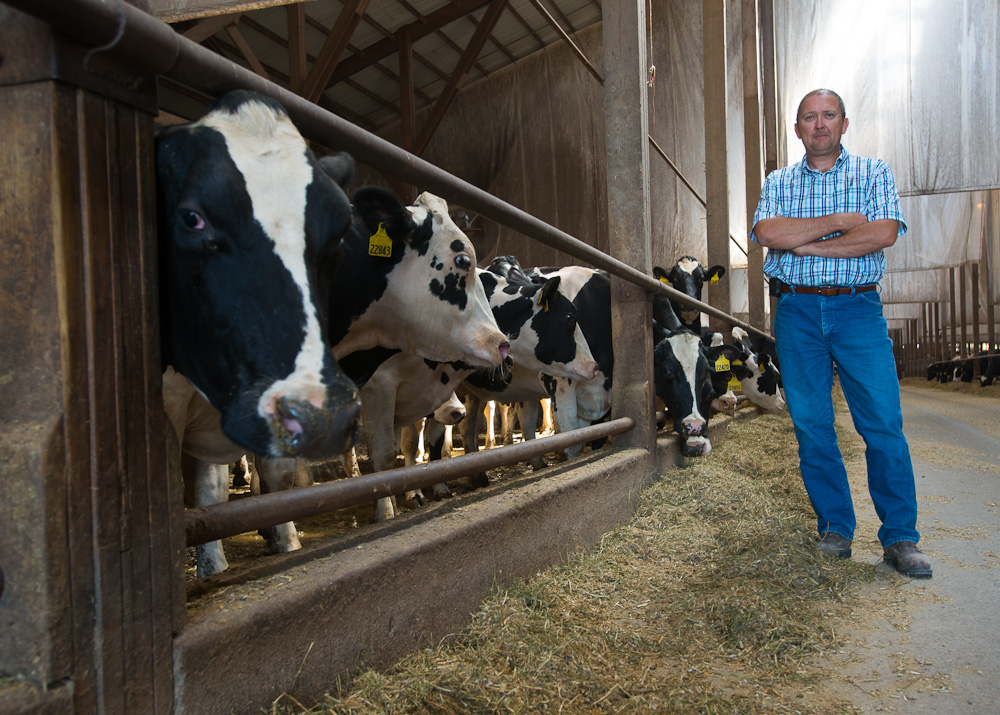Drought dries dairy profits

By Joseph L. Murphy
I’ve been trying my hand at cooking lately and found that many recipes I make require milk. It wasn’t until a recent visit to a dairy farm that I discovered milk has its own ingredient list. Items like Hay, corn, soybean meal and silage are the ingredients that help to make delicious and nutritious milk. What happens when those ingredients dry up?
Kelly Cunningham, a Managing Partner of Milk Unlimited Dairy Farms in Atlantic, worries that drought conditions will continue to impact the dairy industry. (Photo: Joseph L. Murphy)
Those ingredients, or feed supplies, are becoming harder and harder to find as the drought conditions expand across the country. Ingredients like corn, alfalfa, cottonseed and hay have been impacted by the dry weather so availability is becoming less and less.
“My dairy cattle don’t know there is a drought going on,” Kelly Cunningham, a Managing Partner of Milk Unlimited Dairy Farms in Atlantic, said. “We still need to find food for them and to do that we’re bringing in hay from as far away as the four corners region of Utah, Arizona, Colorado and New Mexico.”
It would seem, for dairy farmers across the country, that possession truly is nine-tenths of the law these days. As the drought ruins more and more of the crops, possessing the hay used for feed becomes exceedingly significant in protecting it from other buyers wanting to purchase it for a higher price.
Cunningham manages a dairy farm that has 3400 cows. The cows produce milk in comfort on sand beds and in tunnel ventilated buildings. Those practices help keep the cows comfortable year round. There are 33 employees at the dairy but Cunningham is quick to point out that, for every employee, there are 15 other jobs tied to the farm in the area.
“We like to say that we’re a 15 family farm,” Cunningham said with a smile. “We provide milk to Anderson Erickson in Des Moines four times a day.”
Currently businesses like Anderson Erickson pay around $18 per hundred weight of milk. That number has shrunk from last years price of $23 per hundred weight. Combine that decrease with an increase in feed costs due to the drought and that is a recipe for troubled times.
“My milk has gone down $5 per hundred weight while my feed has gone up 25 percent,” he said. “So it is a double whammy right now.”
Cunningham went on to say that the future price for milk is expected to go up over the next three months so that should give them some relief. The duration of the drought has Cunningham worried about feed supplies for next year and beyond. At those prices, Cunningham will need milk prices to be at $20 or $21 per hundred weight to break even.
“Right now you’re pulling out of your savings account to keep your business running,” Cunningham said. “You can do that as long as you have something in your savings account. So we might have to look at scaling back the cows we milk and try to find cheaper feed. We have to make up that money from somewhere.”
Alternative feeds have been one way of closing the feed cost gap for his dairy. Ingredients like Molasses, beet pulp, and cottonseed have helped to supplement the diets of the cows while using less of the expensive commodities like corn and hard to find ingredients like hay.
“We are doing things every day to prepare for the future and prepare for the volatility,” Cunningham said. “We have cheaper feed in this area because this is where everything is grown. That gives us an advantage over other areas of the country that have to pay transportation costs to get their feed. Here in the Midwest we have as good of a chance as anyone to make it.”
Cunningham went on to say that the costs that they are paying for feed ingredients will raise the cost of ingredients in the food that we eat. So next year the gallon of milk pulled from the cooler at the grocery store could cost you 20 percent more.
Originally published for the Iowa Soybean Association. Find more great stories at: www.iasoybeans.com/news
For more than two decades, Joseph L. Murphy has had the pleasure of meeting and connecting with people from all walks of life through photography. He has photographed presidents and heads of state, traversed the winding alleyways of the Fes Medina in Morocco, photographed the sprawling countryside and people that make up Argentina and covered events that have defined the U.S. Most recently, Murphy’s travels have taken him to Cambodia, Mexico, China, Vietnam and Ecuador.
He has spent the past 20 years specializing in agriculture photography for multiple organizations, publications and marketing projects.
A graduate of the University of Iowa, Murphy determined at an early age that his love of photography would shape his vision for life.
